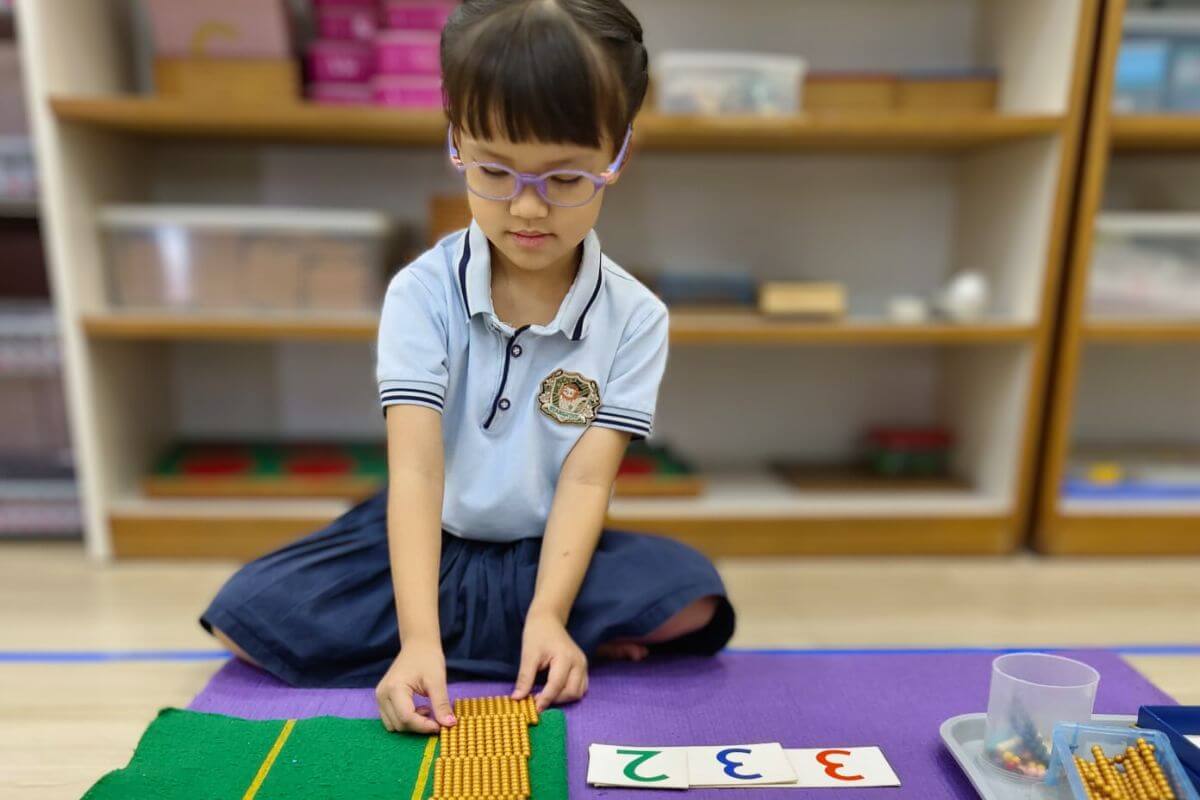Introduction
In today’s rapidly evolving world, teaching children about money early on is essential to developing lifelong financial literacy. One of the most effective approaches to introducing money concepts to young children is the Montessori method. Montessori education focuses on hands-on, child-led learning, making it the perfect environment for preschoolers to explore financial concepts like saving, spending, and understanding the value of money.
At Starshine Montessori, we believe that early financial education sets the foundation for long-term success. This article explores how the Montessori method helps preschoolers in Singapore learn about money, key financial concepts for young children, and practical activities that parents can use to reinforce these lessons at home.
The Montessori Approach to Teaching Money
Hands-On, Child-Centered Learning
The Montessori method is built on the principles of experiential learning, where children engage with real-world tasks in a structured and supportive environment. Financial literacy can seem like a complex topic, but in Montessori settings, children naturally absorb money concepts through hands-on activities. This child-centered approach empowers preschoolers to learn at their own pace, exploring real-life scenarios like sorting coins, counting, and even making simple purchasing decisions during role-play.
At Starshine Montessori, we integrate financial literacy into everyday activities, allowing children to gain a deeper understanding of how money works in their world. Through these practical experiences, children learn essential life skills that will benefit them as they grow older.
To learn more about the role of hands-on learning in the Montessori system, you can explore our article on how the Montessori Method equips children for real-world success.
Practical Life Skills and Financial Concepts
Montessori education emphasizes “Practical Life” activities—tasks that teach children to take care of themselves and their environment. When it comes to money, these activities help preschoolers develop a sense of responsibility, patience, and delayed gratification. For example, through setting up a mini-shop or managing a pretend piggy bank, children can practice saving, spending, and making choices.
Financial literacy, like all Montessori lessons, is about helping children gain independence. Money-related activities build decision-making skills and encourage children to take ownership of their choices. This is vital as it empowers them to become financially responsible individuals in the future.
For more insights into how children develop independence through Montessori activities, read Empowering Young Minds: Innovative Activities for Positive Growth.
Role of the Montessori Environment in Learning Money Skills
In a Montessori classroom, the environment is carefully curated to foster independent learning. Materials are thoughtfully arranged to encourage children to explore freely, and this includes money-related activities. Preschoolers can access activities that allow them to touch, sort, and count coins or explore real-world scenarios like managing a small budget in a controlled, safe environment.
These immersive experiences help children understand the concept of money beyond abstract terms. At Starshine Montessori, our classrooms are designed to cultivate curiosity and develop problem-solving skills, which are essential in understanding financial literacy.
Key Financial Concepts for Preschoolers
Understanding the Concept of Money
Introducing preschoolers to the concept of money starts with simple explanations—what money is, how it’s used, and why it’s valuable. Children at this age are naturally curious about the world, and you can harness this curiosity by showing them examples of coins, notes, or even digital transactions.
One effective approach is using role-playing to simulate real-world financial exchanges. For instance, setting up a mini grocery store allows children to practice making “purchases” with play money. This helps them understand the basics of money transactions and the idea of exchange.
Saving vs. Spending: Simple Lessons for Preschoolers
Teaching preschoolers the difference between saving and spending is a crucial component of financial literacy. At Starshine Montessori, we incorporate activities such as “piggy bank goals,” where children are encouraged to save coins over time for a specific reward or item. This helps them develop patience and understand the value of delayed gratification.
Children are also introduced to spending by giving them opportunities to make small purchasing decisions during activities. These choices teach them that spending money should be thoughtful and intentional.
For parents looking to reinforce these lessons at home, consider reading Does Your Preschool Offer Real Value?, which highlights how quality early education can support holistic child development.
Learning About Needs vs. Wants
Another vital money concept for preschoolers is distinguishing between needs and wants. Children are naturally inclined to want everything, but helping them understand that some things are necessary (needs) and others are simply nice to have (wants) lays the groundwork for responsible spending.
A simple exercise is to create two jars labeled “needs” and “wants” and have your child sort items or images of things they encounter in daily life. This visual representation helps them grasp the importance of prioritising essential needs over non-essential desires.
Montessori Activities to Teach Financial Literacy
Activity 1: Sorting and Counting Coins
Sorting and counting coins is a classic Montessori activity that helps children understand basic money concepts. At Starshine Montessori, we use real coins in various denominations and allow children to explore them independently. This tactile experience familiarises them with different values and reinforces their ability to categorise, which is a core math skill.
This activity also teaches children how to count money and reinforces early math concepts. If you want to know more about how Montessori integrates math and financial literacy, check out our article on Engaging Children in Maths and Science.
Activity 2: The Montessori Shop Setup: Role-playing with Money
Role-playing is a powerful way to help children practice real-world money skills. In a Montessori classroom, we set up mini-shop scenarios where children can “buy” items using play money. This encourages children to make purchasing decisions and understand the exchange of goods for money.
This activity can also be easily recreated at home. Parents can set up a mock store where children use small amounts of real or play money to “buy” toys, snacks, or art supplies. Through this playful experience, children learn about budgeting, making choices, and basic math skills like addition and subtraction.
For more tips on how play enhances cognitive development, you can read The Role of Play in Enhancing Cognitive Development in Early Childhood.
Activity 3: Piggy Bank and Saving Goals
A Montessori-inspired piggy bank activity teaches children about the importance of saving. Encourage your child to set a small goal, such as saving for a new book or toy. Each time they receive money (even just coins), they can add it to their piggy bank and track their progress toward the goal.
This activity helps preschoolers develop patience and reinforces the idea that saving over time leads to rewards. It’s a simple but powerful way to build financial responsibility from an early age.
How to Incorporate Money Lessons into Daily Life
Everyday Opportunities to Talk About Money
Financial education doesn’t have to be confined to the classroom. There are countless opportunities to introduce your child to money concepts during daily activities. Whether you’re shopping for groceries or paying for a family meal, involve your child in these discussions. You can talk about how much things cost, why you’re choosing one item over another, and how budgeting works.
By integrating money lessons into your everyday routine, you help reinforce the concepts they’re learning at school and make financial literacy a natural part of their development.
Involving Your Preschooler in Family Shopping Decisions
One effective way to teach preschoolers about money is to involve them in simple shopping decisions. For example, while grocery shopping, you can give your child a small budget to “spend” on snacks or items for the family. This not only teaches them about money but also helps them practice making decisions, comparing prices, and understanding value.
If you’re interested in exploring how Montessori prepares children for decision-making and critical thinking, our article on Inquiry-Based Learning provides further insights.
Simple Money-Related Chores to Foster Responsibility
Assigning small, money-related chores at home is another way to build financial literacy. Tasks like sorting coins, managing a small allowance, or even helping to calculate savings for a family outing can teach preschoolers about the value of earning and saving money.
Benefits of Early Financial Education for Preschoolers
Developing Smart Money Habits from a Young Age
Early exposure to money concepts helps preschoolers build smart money habits that can last a lifetime. By learning to save, spend wisely, and differentiate between needs and wants, children develop a healthy relationship with money that will serve them well as they grow older.
Building Decision-Making and Problem-Solving Skills
Financial education also fosters decision-making and problem-solving skills. When children are faced with choices—whether to save or spend, what to buy, or how to manage a small budget—they learn how to weigh options and think critically.
This ties directly into how Montessori education encourages independence and self-confidence in children. You can explore more about these benefits in Raising Confident Children: Expert Tips for Parents.
Fostering Independence and Confidence with Money
One of the core principles of Montessori education is fostering independence. When children are empowered to make their own decisions—whether financial or otherwise—they gain confidence in their abilities and learn to take responsibility for their choices.
Montessori Tips for Parents
Encouraging Patience and Learning at Your Child’s Pace
Every child learns differently, and it’s important to let them explore financial concepts at their own pace. Montessori education encourages children to take the time they need to absorb new information, so parents should provide the same freedom at home.
Reinforcing Financial Concepts at Home
To solidify the lessons learned in a Montessori classroom, parents can create simple, everyday activities that reinforce financial concepts. Whether it’s through daily chores, saving for a small reward, or role-playing, these activities provide valuable learning opportunities outside of school.
Adapting Money Lessons to Your Child’s Developmental Stage
As your child grows, their understanding of money will evolve. It’s essential to adapt your lessons to their developmental stage, introducing more complex financial concepts over time. Montessori’s individualised approach ensures that children are always learning at a level that’s appropriate for them.
Conclusion
Early financial education plays a crucial role in shaping a child’s understanding of money, responsibility, and decision-making. Through the Montessori method, preschoolers are given the tools they need to explore financial concepts in a hands-on, engaging way. At Starshine Montessori, we believe that these lessons form the foundation for long-term financial success, empowering children to navigate the world with confidence and independence.
To learn more about how Montessori education nurtures independence and critical thinking, you can explore How Montessori Method Equips Children for Real-World Success.
By incorporating Montessori money lessons both at school and at home, you can help your child build a healthy relationship with money and develop essential skills for their future.
Follow us on social media to stay updated on our latest updates and happenings:







Comments are closed